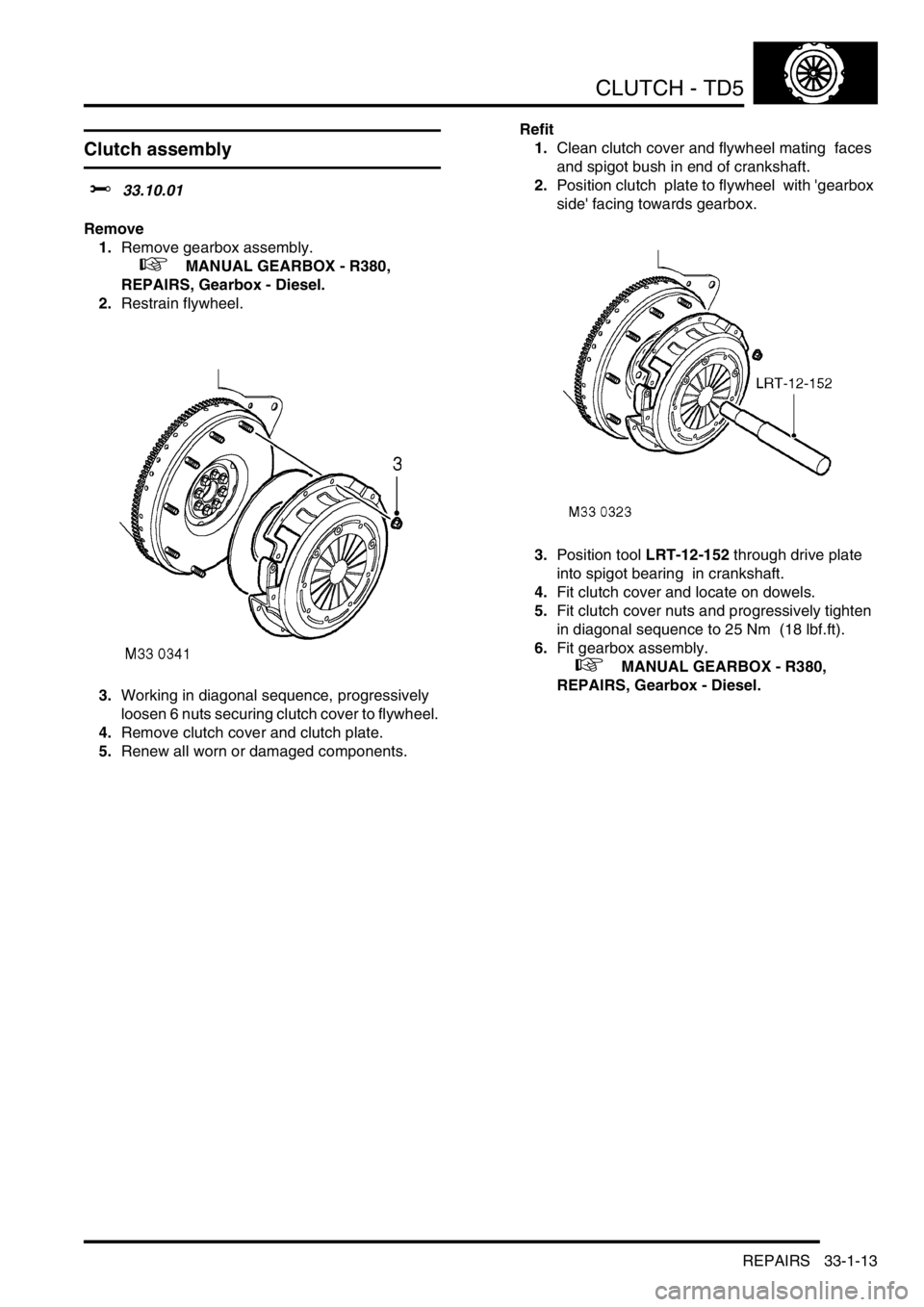tow LAND ROVER DISCOVERY 2002 Owner's Guide
[x] Cancel search | Manufacturer: LAND ROVER, Model Year: 2002, Model line: DISCOVERY, Model: LAND ROVER DISCOVERY 2002Pages: 1672, PDF Size: 46.1 MB
Page 485 of 1672

ENGINE MANAGEMENT SYSTEM - V8
18-2-28 DESCRIPTION AND OPERATION
The HO2S can fail the following ways or supply incorrect signal:
lSensor open circuit.
lShort circuit to vehicle supply.
lShort circuit to vehicle earth.
lSensor disconnected.
lStoichiometric ratio outside the correct operating band.
lContamination from leaded fuel.
lAir leak into the exhaust system.
lWiring loom damage.
lSensors fitted incorrectly or cross wired.
In the event of a HO
2S signal failure any of the following symptoms may be observed:
lDefault to open loop fuelling on defective bank.
lIf the sensors are crossed over (LH bank to RH bank), the engine will run normally after initial start up, but
performance will become progressively worse as the sensors go towards maximum rich for one bank of cylinders
and maximum lean for the other. The ECM will eventually default into open loop fuelling.
lHigh CO reading.
lExcess emissions.
lStrong hydrogen sulphide (H
2S) smell until the ECM defaults to open loop fuelling. .
lMIL illuminated (NAS market only).
A number of diagnostic tests are performed by the ECM with regards to the HO
2sensors:
lHO
2 sensor and system diagnostics
lHO
2 sensor heater diagnostics
lHO
2 sensor switching period (ageing) diagnostics
lRear HO
2 sensor adaption diagnostic (NAS only)
lCatalyst monitoring diagnostic
For further details of the heated oxygen sensors and exhaust emission control, refer to the V8 Emission Control
section of this manual.
+ EMISSION CONTROL - V8, DESCRIPTION AND OPERATION, Exhaust emission control system.
Should a malfunction of the component occur the following fault codes may be evident and can be retrieved by
TestBook:
P Code J2012 Description Land Rover Description
P1129 O
2 sensors swapped bank to bank (sensor 1) Front sensors transposed
P0130 O
2 sensor circuit malfunction (bank 1, sensor 1) Front sensor LH bank stoichiometric ratio outside
operating band
P0132 O
2 sensor circuit high voltage (bank 1, sensor 1) Front sensor LH bank short circuit to battery supply
P0134 O
2 sensor circuit no activity detected (bank 1,
sensor 1)Front sensor LH bank open circuit
P0150 O
2 sensor circuit malfunction (bank 2, sensor 1) Front sensor RH bank stoichiometric ratio outside
operating band
P0152 O
2 sensor circuit high voltage (bank 2, sensor 1) Front sensor RH bank short circuit to battery supply
P0154 O
2 sensor circuit no activity detected (bank 2,
sensor 1)Front sensor RH bank open circuit
P0136 O
2 sensor circuit malfunction (bank 1, sensor 2) Rear sensor LH bank stoichiometric ratio outside
operating band (NAS only)
P0137 O
2 sensor circuit low voltage (bank 1, sensor 2) Rear sensor LH bank short circuit to earth (NAS only)
P0138 O
2 sensor circuit high voltage (bank 1, sensor 2) Rear sensor LH bank short circuit to battery supply
(NAS only)
P0140 O
2 sensor circuit no activity detected (bank 1,
sensor 2)Rear sensor LH bank open circuit (NAS only)
P0156 O
2 sensor circuit malfunction (bank 2, sensor 2) Rear sensor RH bank stoichiometric ratio outside
operating band (NAS only)
P0157 O
2 sensor circuit low voltage (bank 2, sensor 2) Rear sensor RH bank short circuit to earth (NAS only)
Page 625 of 1672

MANIFOLDS AND EXHAUST SYSTEMS - TD5
30-1-4 DESCRIPTION AND OPERATION
Front pipe assembly
The front pipe is of welded and fabricated tubular construction. The front pipe is connected to a flange on the
turbocharger and secured with three flanged nuts and sealed with a metal laminated gasket. The front pipe
incorporates a flexible pipe near the connection with the turbocharger and terminates in a flanged connection with the
intermediate pipe.
The flexible pipe is formed into a concertina shape with woven metal strands around its outer diameter. The flexible
pipe allows for ease of exhaust system alignment and also absorbs engine vibration. The woven metal strands also
increase the longevity of the flexible pipe.
The front pipe is attached via a bracket and a mounting rubber to the chassis. The mounting rubber allows ease of
alignment and vibration absorption.
Intermediate pipe and silencer
The intermediate pipe is of welded and fabricated tubular construction. It connects at its forward end to the front pipe
flange. Two captive studs on the intermediate pipe flange allow for attachment to the front pipe with locknuts. The rear
section of intermediate pipe connects to the tail pipe assembly via a flanged joint, sealed with a metal gasket and
secured with locknuts and studs.
The forward and rear sections are joined by a silencer. The silencer is fabricated from stainless steel sheet to form
the body of the silencer. An end plate closes each end of the silencer and is attached to the body with seam joints.
Perforated baffle tubes, inside the silencer, are connected to the inlet and outlet pipes on each end plate. Internal
baffle plates support the baffle tubes and, together with a stainless steel fibre packing, absorb combustion noise as
the exhaust gases pass through the silencer.
The intermediate pipe is attached by two brackets, positioned at each end of the silencer, and two mounting rubbers
to the chassis. The mounting rubber allows for ease of alignment and vibration absorption.
Tail pipe assembly
The tail pipe is of welded and fabricated construction. The tail pipe connects to the intermediate pipe with a flanged
joint secured with locknuts and sealed with a metal gasket. The pipe is shaped to locate above the rear axle allowing
clearance for axle articulation. The pipe is also curved to clear the left hand side of the fuel tank which has a reflective
shield to protect the tank from heat generated from the pipe.
A fabricated silencer is located at the rear of the tail pipe. The silencer is circular in section and is constructed from
stainless steel sheet. A baffle tube is located inside the silencer and the space around the baffle tube is packed with
a stainless steel fibre. The holes in the baffle tube allow the packing to further reduce combustion noise from the
engine. The tail pipe from the silencer is curved downwards at the rear of the vehicle and directs exhaust gases
towards the ground. The curved pipe allows the exhaust gases to be dissipated by the airflow under the vehicle and
prevents the gases from being drawn behind the vehicle.
The tail pipe is attached by a bracket, positioned forward of the silencer, and a mounting rubber to the chassis. The
mounting rubber allows ease of alignment and vibration absorption.
Page 636 of 1672

MANIFOLDS AND EXHAUST SYSTEMS - V8
DESCRIPTION AND OPERATION 30-2-7
Tail pipe assembly
The tail pipe is of welded and fabricated construction. It connects to the intermediate pipe with a flanged joint secured
with studs and locknuts and sealed with a metal gasket. The pipe is shaped to locate above the rear axle allowing
clearance for axle articulation. The pipe is also curved to clear the left hand side of the fuel tank which has a reflective
shield to protect the tank from heat generated from the pipe.
A fabricated silencer is located at the rear of the tail pipe. The silencer is circular in section and is constructed from
stainless steel sheet. A baffle tube is located inside the silencer and the space around the baffle tube is packed with
a stainless steel fibre. The holes in the baffle tube allow the packing to further reduce combustion noise from the
engine. The tail pipe from the silencer is curved downwards at the rear of the vehicle and directs exhaust gases
towards the ground. The curved pipe allows the exhaust gases to be dissipated by the airflow under the vehicle and
prevents gases being drawn behind the vehicle.
The tail pipe is attached by a bracket, positioned forward of the silencer, and a mounting rubber to the chassis. The
mounting rubber allows ease of alignment and vibration absorption.
Page 661 of 1672

CLUTCH - TD5
33-1-10 DESCRIPTION AND OPERATION
Operation
Hydraulic operation
Refer to illustration.
+ CLUTCH - Td5, DESCRIPTION AND OPERATION, Hydraulic operation.
When the clutch pedal is depressed, the master cylinder piston is pushed into the master cylinder. The movement of
the piston pressurises the fluid in the master cylinder, forcing the pressurised fluid into the hydraulic feed pipe to the
slave cylinder. The hydraulic pressure is felt at the slave cylinder piston which moves under the hydraulic force
applied, pushing the clutch release lever via the piston rod.
When the clutch pedal is released, the force applied to the release lever by the fingers of the diaphragm, moves the
release lever, which pushes the slave cylinder piston into the cylinder. The displaced hydraulic fluid is pushed up the
hydraulic feed pipe and returns to the master cylinder.
Mechanism operation
When the clutch pedal is depressed, hydraulic pressure extends the piston and rod in the slave cylinder. The
extension of the piston pushes the rod against the outer end of the release lever which pivots around the ball spigot.
The inner end of the release lever pivots towards the engine applying pressure to the release bearing. The release
bearing slides along the release bearing sleeve and pushes on the fingers of the diaphragm. The diaphragm pivots
around the chamfered rivets in the cover. As the diaphragm is deflected, it removes pressure from the pressure plate.
The pressure plate moves away from the drive plate assisted by the three leaf springs.
The removal of force from the pressure plate on the drive plate reduces the friction between the dual mass flywheel,
drive plate and pressure plate. The drive plate slips between the flywheel and the pressure plate preventing rotary
movement being transferred from the flywheel and pressure plate to the primary driveshaft.
When the clutch pedal is released, hydraulic force is removed from the piston in the slave cylinder. This allows the
fingers of the diaphragm to push the release bearing along the release bearing sleeve. The movement of the release
bearing moves the release lever which pivots on the ball spigot, pushing the piston and rod back into the slave
cylinder.
The removal of pressure from the release bearing on the diaphragm, causes the diaphragm to pivot around the
chamfered rivets in the cover. The force applied to the pressure plate from the diaphragm overcomes the force of the
leaf springs and the pressure plate moves towards the drive plate and flywheel.
The pressure plate applies pressure to the drive plate which is pushed against the flywheel. As the clutch pedal is
progressively released, the friction between the drive plate, flywheel and pressure plate increases. The increase in
friction transfers the rotary movement of the flywheel and pressure plate to the drive plate, which in turn starts to rotate
the primary drive shaft. When the clutch pedal is released fully, the force applied by the diaphragm to the pressure
plate forces the drive plate onto the flywheel with no slippage.
Page 664 of 1672

CLUTCH - TD5
REPAIRS 33-1-13
REPAIRS
Clutch assembly
$% 33.10.01
Remove
1.Remove gearbox assembly.
+ MANUAL GEARBOX - R380,
REPAIRS, Gearbox - Diesel.
2.Restrain flywheel.
3.Working in diagonal sequence, progressively
loosen 6 nuts securing clutch cover to flywheel.
4.Remove clutch cover and clutch plate.
5.Renew all worn or damaged components.Refit
1.Clean clutch cover and flywheel mating faces
and spigot bush in end of crankshaft.
2.Position clutch plate to flywheel with 'gearbox
side' facing towards gearbox.
3.Position tool LRT-12-152 through drive plate
into spigot bearing in crankshaft.
4.Fit clutch cover and locate on dowels.
5.Fit clutch cover nuts and progressively tighten
in diagonal sequence to 25 Nm (18 lbf.ft).
6.Fit gearbox assembly.
+ MANUAL GEARBOX - R380,
REPAIRS, Gearbox - Diesel.
Page 677 of 1672

CLUTCH - V8
33-2-10 DESCRIPTION AND OPERATION
Operation
Hydraulic operation
Refer to illustration.
+ CLUTCH - V8, DESCRIPTION AND OPERATION, Hydraulic operation.
When the clutch pedal is depressed, the master cylinder piston is pushed into the master cylinder. The movement of
the piston pressurises the fluid in the master cylinder, forcing the pressurised fluid into the hydraulic feed pipe to the
slave cylinder. The hydraulic pressure is felt at the slave cylinder piston which moves under the hydraulic force
applied, pushing the clutch release lever via the piston rod.
When the clutch pedal is released, the force applied to the release lever by the fingers of the diaphragm, moves the
release lever, which pushes the slave cylinder piston into the cylinder. The displaced hydraulic fluid is pushed up the
hydraulic feed pipe and returned to the master cylinder.
Mechanism operation
When the clutch pedal is depressed, hydraulic pressure extends the piston and rod in the slave cylinder. The
extension of the piston pushes the rod against the outer end of the release lever which pivots around the ball spigot.
The inner end of the release lever pivots towards the engine applying pressure to the release bearing. The release
bearing slides along the release bearing sleeve and pushes on the fingers of the diaphragm. The diaphragm pivots
about the fulcrum rings in the cover. As the diaphragm is deflected, it removes pressure from the pressure plate. The
pressure plate moves away from the drive plate assisted by the three leaf springs and retractor clips.
The removal of force from the pressure plate on the drive plate reduces the friction between the flywheel, drive plate
and pressure plate. The drive plate slips between the flywheel and the pressure plate preventing rotary movement
being transferred from the flywheel and pressure plate to the primary driveshaft.
When the clutch pedal is released, hydraulic force is removed from the piston in the slave cylinder. This allows the
fingers of the diaphragm to push the release bearing along the release bearing sleeve. The movement of the release
bearing moves the release lever which pivots on the ball spigot, pushing the piston and rod back into the slave
cylinder.
The removal of pressure from the release bearing on the diaphragm, causes the diaphragm to pivot around the
fulcrum rings in the cover. The force applied to the pressure plate from the diaphragm overcomes the force of the leaf
springs and the pressure plate moves towards the drive plate and flywheel.
The pressure plate applies pressure to the drive plate which is pushed against the flywheel. As the clutch pedal is
progressively released, the friction between the drive plate, flywheel and pressure plate increases. The increase in
friction transfers the rotary movement of the flywheel and pressure plate to the drive plate which in turn starts to rotate
the primary driveshaft. When the clutch pedal is released fully, the force applied by the diaphragm to the pressure
plate forces the drive plate onto the flywheel with no slippage.
Page 707 of 1672

MANUAL GEARBOX - R380
37-24 REPAIRS
6.Move radiator towards engine sufficiently only
to release gearbox oil cooler from radiator.
7.Remove gearbox oil cooler.
CAUTION: Always fit plugs to open
connections to prevent contamination.
Refit
1.Fit gearbox oil cooler to radiator, engage in
location and secure with screw.
2.Ensure connections are clean and secure
hoses to cooler.
3. If fitted: Fit engine oil cooler.
+ ENGINE - V8, REPAIRS, Cooler -
engine oil.
4.Top up gearbox oil.
+ MAINTENANCE, PROCEDURES,
Manual gearbox.
Switch - Reverse light
$% 37.27.01
Remove
1.Raise vehicle on ramp.
2.Disconnect reverse lamp switch multiplug.
3.Remove switch and collect sealing washer.
Refit
1.Clean switch and mating face on gearbox.
2.Using a new sealing washer, fit the reverse light
switch and tighten to 24 Nm (17 lbf.ft).
3.Connect switch multiplug.
4.Lower vehicle.
Page 720 of 1672

MANUAL GEARBOX - R380
OVERHAUL 37-37
13.Fit oil pick-up pipe with the off-set uppermost.
14.Lubricate oil pump recess with gearbox oil.
15.Lubricate a new 'O' ring with gearbox oil and fit
to oil pump.
16.Locate oil pump in extension housing with word
'TOP' towards top of housing.
17.Align oil pump fixing screw holes and tap pump
lightly around edges until it is fully in recess.
Do not attempt to pull pump into recess
using fixing screws.
18.Fit Torx screws and tighten to 6 Nm (4.5 lbf.ft).
19.Remove 2 slave bolts securing centre plate to
gearbox casing.
20.Apply sealant, Part No. STC 3254 to gearbox
casing face.
21.Position extension housing, align oil pump drive
with layshaft.
22.Clean extension housing bolt threads.
23.Apply Loctite 290 to threads of extension
housing bolts, fit bolts ensuring 2 longest bolts
are in their original positions and tighten by
diagonal selection to 25 Nm (18 lbf.ft).
24.Using new 'O' ring, fit interlock spool retainer
and tighten bolt to 8 Nm (6 lbf.ft).
25.Using tool LRT-37-015 and LRT-37-021, fit oil
seal collar.
26.Clean gear selector selector housing and
mating face.
27.Apply sealant, Part No. STC 3254 to gear
selector housing face.
28.Position gear selector housing and tighten
bolts to 25 Nm (18 lbf.ft).
Pump - gearbox oil
$% 37.12.47
Disassembly
1.Remove gearbox extension.
+ MANUAL GEARBOX - R380,
OVERHAUL, Extension - gearbox rear.
2.Remove 3 Torx screws, remove oil pump and
discard 'O' ring.
Reassembly
1.Clean oil pump recess in extension housing,
ensure screw holes are clean and dry.
2.Lubricate oil pump recess in housing with
gearbox oil.
3.Lubricate a new 'O' ring with gearbox oil and fit
to oil pump.
4.Locate oil pump in extension housing with word
'TOP' towards top of housing.
5.Align fixing screw holes and tap pump lightly
around edges until pump is fully in housing. Do
not pull pump into housing by tightening
screws.
6.Fit Torx screws and tighten to 6 Nm (4.5 lbf.ft).
7.Fit gearbox extension.
+ MANUAL GEARBOX - R380,
OVERHAUL, Extension - gearbox rear.
Page 724 of 1672

MANUAL GEARBOX - R380
OVERHAUL 37-41
5.Remove retaining ring and split collars
securing 5th gear to output shaft.
6.Remove split collar and 5th gear from layshaft. Reassembly
1.Clean gear and layshaft.
2.Position 5th gear and split collar to layshaft
ensuring that bevelled side of collar is towards
5th gear.
3.Position split collars and retaining ring securing
5th gear to output shaft.
4.Position tool LRT-37-023 to hold 5th gear and
tighten new stake nut to 220 Nm (162 lbf.ft) and
stake nut.
5.Apply a small amount of heat and fit support
bearing track to layshaft.
6.Fit gearbox extension.
+ MANUAL GEARBOX - R380,
OVERHAUL, Extension - gearbox rear.
Page 725 of 1672

MANUAL GEARBOX - R380
37-42 OVERHAUL
Bearing - layshaft rear support
$% 37.20.58
Disassembly
1.Remove extension housing.
+ MANUAL GEARBOX - R380,
OVERHAUL, Extension - gearbox rear.
2.Remove 3 Torx screws, remove oil pump and
discard 'O' ring.
3.Drift out layshaft support bearing.
4.Using a suitable two legged puller remove 5th
gear layshaft support bearing track from end of
layshaft. Reassembly
1.Clean layshaft and bearing recess in extension
housing.
2.Fit layshaft support bearing.
3.Clean oil pump recess in extension housing,
ensure screw holes are clean and dry.
4.Lubricate oil pump recess in housing with
gearbox oil.
5.Lubricate a new 'O' ring with gearbox oil and fit
to oil pump.
6.Locate oil pump in extension housing with word
'TOP' towards top of housing.
7.Align fixing screw holes and tap pump lightly
around edges until pump is fully in housing. Do
not pull pump into housing by tightening
screws.
8.Fit Torx screws and tighten to 6 Nm (4.5 lbf.ft).
9.Apply a small amount of heat and fit support
bearing track to layshaft.
10.Fit extension housing.
+ MANUAL GEARBOX - R380,
OVERHAUL, Extension - gearbox rear.